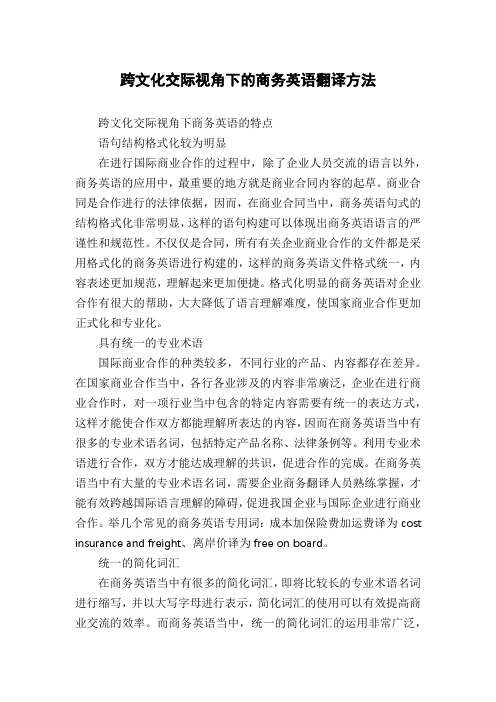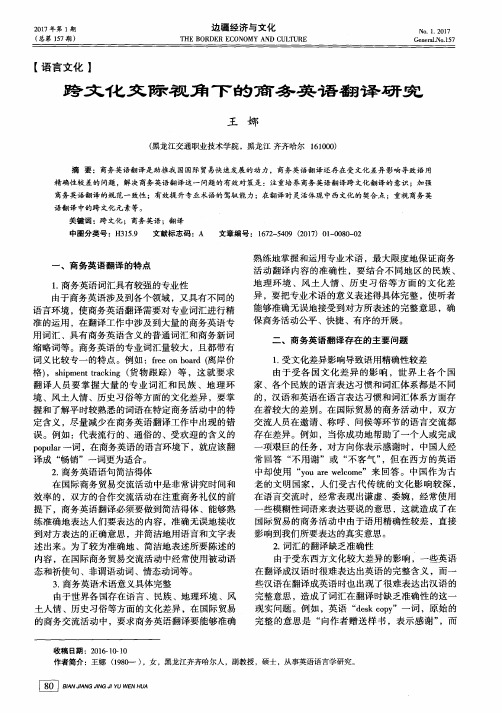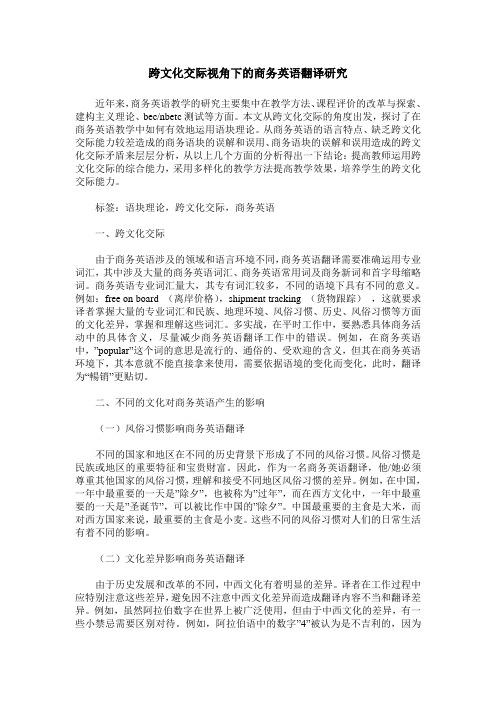跨文化交际视角下的电子商务英语翻译
- 格式:doc
- 大小:22.50 KB
- 文档页数:6

跨文化交际视角下的商务英语翻译方法跨文化交际视角下商务英语的特点语句结构格式化较为明显在进行国际商业合作的过程中,除了企业人员交流的语言以外,商务英语的应用中,最重要的地方就是商业合同内容的起草。
商业合同是合作进行的法律依据,因而,在商业合同当中,商务英语句式的结构格式化非常明显,这样的语句构建可以体现出商务英语语言的严谨性和规范性。
不仅仅是合同,所有有关企业商业合作的文件都是采用格式化的商务英语进行构建的,这样的商务英语文件格式统一,内容表述更加规范,理解起来更加便捷。
格式化明显的商务英语对企业合作有很大的帮助,大大降低了语言理解难度,使国家商业合作更加正式化和专业化。
具有统一的专业术语国际商业合作的种类较多,不同行业的产品、内容都存在差异。
在国家商业合作当中,各行各业涉及的内容非常廣泛,企业在进行商业合作时,对一项行业当中包含的特定内容需要有统一的表达方式,这样才能使合作双方都能理解所表达的内容,因而在商务英语当中有很多的专业术语名词,包括特定产品名称、法律条例等。
利用专业术语进行合作,双方才能达成理解的共识,促进合作的完成。
在商务英语当中有大量的专业术语名词,需要企业商务翻译人员熟练掌握,才能有效跨越国际语言理解的障碍,促进我国企业与国际企业进行商业合作。
举几个常见的商务英语专用词:成本加保险费加运费译为cost insurance and freight、离岸价译为free on board。
统一的简化词汇在商务英语当中有很多的简化词汇,即将比较长的专业术语名词进行缩写,并以大写字母进行表示,简化词汇的使用可以有效提高商业交流的效率。
而商务英语当中,统一的简化词汇的运用非常广泛,通过简化词汇,合作双方可以清晰了解对方说的含义。
商务英语当中,被简化的英语词汇一般都是一个行业内的专业术语或专有名词,是企业合作双方都知晓和理解的词汇。
当然,在利用简化词汇时需要保证词汇运用的准确性和真实性,并不能随意编造简化词汇,这样反而容易造成合作双方理解的差异。


跨文化交际视角下商务英语的翻译方法探究语言是文化的一部分,是文化传播的重要载体。
不同国家,其文化、历史、政治和宗教等情况不尽相同,对跨国商务交流造成了障碍。
相较普通英语翻译,商务英语作为一种专门用途的英语分支,包含内容更广泛,所需知识更专业。
因此,在跨文化背景下获得良好的文化自适、扩展专业知识储备、把握准确的翻译策略,对提升翻译质量具有重大现实意义。
1 英语翻译的功能对等1969年,美国著名的语言学家Eugene Nida提出了功能对等的概念。
所谓“功能对等”,是指翻译时不要求生硬的文字对应,而是实现两种语言之间功能和用途上的对等,追求语义表达的自然流畅和恰如其分。
而基于美国著名语言学家Noam Chomsky提出的深层结构和表层结构的划分,在翻译过程中的这种对等又分为两种:一种称为正式对等(formal equivalence),另一种被称为动态对等(dynamic equivalence)。
前者“主要关注形式和内容两方面的信息本身的传递”,重点强调表面层次上一一对应的翻译。
而后者则强调用自然、贴切的对等表达形式再现源语的内容。
重点在于意义,其次才是文体。
而这种贴切的对等表达想要实现从头到脚完全对等几乎是不可能的,所以它指的是最大限度上的相似对等。
而自然是指目的语读者阅读译作时对语言顺滑流畅的感受,几乎感受不到翻译腔的存在,毫无违和感。
Eugene Nida显然更倾向于使用后一种翻译理念,更加重视读者的感受,即“译文读者对译文的理解和反应与原文读者对原文的理解和反应相同”。
2 商务英语翻译的原则及特征2.1 专业原则商务英语涉及大量专业术语,有极强的针对性和专业性,涉及的学科门类知识比普通英语翻译更为庞杂,很多词在商务环境中和普通英语中的意义截然不同。
商务英语译员既要灵活运用专业词法,又要对不同地域的文化、经济、金融、法学等拥有全面的知识储备,实施恰如其分的翻译,避免误译、错译而引发商业纠纷和经济损失。

跨文化交际视角下的商务英语翻译研究近年来,商务英语教学的研究主要集中在教学方法、课程评价的改革与探索、建构主义理论、bec/nbetc测试等方面。
本文从跨文化交际的角度出发,探讨了在商务英语教学中如何有效地运用语块理论。
从商务英语的语言特点、缺乏跨文化交际能力较差造成的商务语块的误解和误用、商务语块的误解和误用造成的跨文化交际矛盾来层层分析,从以上几个方面的分析得出一下结论:提高教师运用跨文化交际的综合能力,采用多样化的教学方法提高教学效果,培养学生的跨文化交际能力。
标签:语块理论,跨文化交际,商务英语一、跨文化交际由于商务英语涉及的领域和语言环境不同,商务英语翻译需要准确运用专业词汇,其中涉及大量的商务英语词汇、商务英语常用词及商务新词和首字母缩略词。
商务英语专业词汇量大,其专有词汇较多,不同的语境下具有不同的意义。
例如:free on board (离岸价格),shipment tracking (货物跟踪),这就要求译者掌握大量的专业词汇和民族、地理环境、风俗习惯、历史、风俗习惯等方面的文化差异,掌握和理解这些词汇。
多实战,在平时工作中,要熟悉具体商务活动中的具体含义,尽量减少商务英语翻译工作中的错误。
例如,在商务英语中,”popular”这个词的意思是流行的、通俗的、受欢迎的含义,但其在商务英语环境下,其本意就不能直接拿来使用,需要依据语境的变化而变化,此时,翻译为“暢销”更贴切。
二、不同的文化对商务英语产生的影响(一)风俗习惯影响商务英语翻译不同的国家和地区在不同的历史背景下形成了不同的风俗习惯。
风俗习惯是民族或地区的重要特征和宝贵财富。
因此,作为一名商务英语翻译,他/她必须尊重其他国家的风俗习惯,理解和接受不同地区风俗习惯的差异。
例如,在中国,一年中最重要的一天是”除夕”,也被称为”过年”,而在西方文化中,一年中最重要的一天是”圣诞节”,可以被比作中国的”除夕”。
中国最重要的主食是大米,而对西方国家来说,最重要的主食是小麦。

Unit 2 Page 60 Unit 3 Page 96Unit 5 Page 175 Unit 6 Page 215Case 2A common cultural misunderstanding in classes involves conflicts between what is said to be direct communication style and indirect communication style. In American culture, people tend to say what is on their minds and to mean what they say. Therefore, students in class are expected to ask questions when they need clarification. Mexican culture shares this preference of style with American culture in some situations, and that‘s why the students from Mexico readily adopted the techniques of asking questions in class. However, Korean people generally prefer indirect communication style, and therefore they tend to not say what is on their minds and to rely more on implications and inference, so as to be polite and respectful and avoid losing face through any improper verbal behavior. As is mentioned in the case, to many Koreans, numerous questions would show a disrespect for the teacher, and would also reflect that the student has not studied hard enough.Case 3The conflict here is a difference in cultural values and beliefs. In the beginning, Mary didn’t realize that her Dominican sister saw her as a member of the family, literally. In the Dominican view, family possessions are shared by everyone of the family. Luz was acting as most Dominican sisters would do in borrowing without asking every time. Once Mary understood that there was a different way of looking at this, she would become more accepting. However, she might still experience the same frustration when this happened again. She had to find ways to cope with her own emotional cultural reaction as well as her practical problem (the batteries running out).Case 6When a speaker says something to a hearer, there are at least three kinds ofmeanings involved: utterance meaning, speaker’s meaning and hearer’s meaning. In the dialogue, when Litz said ‘How long is she going to stay?’ she meant to say that if she knew how long her mother-in-law was going to stay in Finland, she would be able to make proper arrangements for her, such as taking her out to do some sightseeing. However, her mother-in-law overheard the conversation, and took Litz’s question to mean “Litz does not want me to stay for long”. From the Chinese point of view, it seems to be inappropriate for Litz to ask such a question just two days after her mother-in-law’s arrival. If she feels she has to ask the question, it would be better to ask some time later and she should not let her mother-in-law hear it.Case 7Keiko insists on giving valuable gifts to her college friends, because in countries like Japan, exchanging gifts is a strongly rooted social tradition. Should you receive a gift, and don’t have one to offer in return, you will probably create a crisis. If not as serious as a crisis, one who doesn’t offer a gift in return may be considered rude or impolite. Therefore, in Japan, gifts are a symbolic way to show appreciation, respect, gratitude and further relationship.Keiko obviously has taken those used items from Mary, Ed and Marion as gifts, for she probably doesn’t know that Americans frequently donate their used household items to church or to the community. Mary, Ed and Marion would never consider those used household items given to Keiko as gifts. No wonder they felt very uncomfortable when they received valuable gifts in return.Case 10In Japan, a company is often very much like a big family, in which the manger(s) will take good care of the employees and the employees are expected to devote themselves to the development of the company and, if it is necessary, to sacrifice their own individual interests for the interests of the company, from which, in the long run, the employees will benefit greatly. But for the French, a company is just a loosely- knit social organization wherein individuals are supposed to take care of themselves and their families. Moreover, the way the French make decisions in the family might also be different from the typical Japanese one, which may not often involve females and the power to decide usually lies with the dominating male. As there are such cultural differences between the Japanese and the French, Mr. Legrand’s decision made Mr. Tanaka feel dumbfounded.Case 12In this case, it seems that the Chinese expectations were not fulfilled. First, having two people sharing host responsibilities could be somewhat confusing to the hierarchically minded Chinese. Second, because age is often viewed as an indication of seniority, the Chinese might have considered the youth of their Canadian hosts as slight to their own status. Third, in China, it is traditional for the host to offer a welcome toast at the beginning of the meal, which is the reciprocated by the guests; by not doing so, the Canadian might be thought rude. The abrupt departure of the Chinese following the banquet was probably an indication that they were not pleased with the way they were treated. The Canadians’ lack of understanding of the Chinese culture and the Chinese ways of communication clearly cost them in their business dealings with the visiting delegation.Case 17When these two men separate, they may leave each other with very different impressions.Mr Richardson is very pleased to have made the acquaintance of Mr Chu and feels they have gotten off to a very good start. They have established their relationship on a first-name basis and Mr Chu’s smile seemed to indicate that he will be friendly and easy to do business with. Mr Richardson is particularly pleased that he had treated Mr Chu with respect for his Chinese background by calling him Hon-fai rather than using the western name, David, which seemed to him an unnecessary imposition of western culture.In contrast, Mr Chu feels quite uncomfortable with Mr Richardson. He feels it will be difficult to work with him, and that Mr Richardson might be rather insensitive to cultural differences. He is particularly bothered that, instead of calling him David or Mr Chu, Mr Richardson used his given name, Hon-fai, the name rarely used by anyone, in fact. It was this embarrassment which caused him to smile. He would feel more comfortable if they called each other Mr Chu and Mr Richardson. Nevertheless, when he was away at school in North America he learned that Americans feel uncomfortable calling people Mr for any extended period of time. His solution was to adopt a western name. He chose David for use in such situations.Case 19Talking about what’s wrong is not easy for people in any culture, but people in high-context countries like China put high priority on keeping harmony, preventing anyone from losing face, and nurturing the relationship. It seems that Ron Kelly had to learn a different way of sending message when he was in China. At home in Canada he would have gone directly to the point. But in China, going directly to the problem with someone may suggest that he or she has failed to live up to his or her responsibility and the honor of his or her organization is in question. In high-context cultures like China, such a message is serious and damaging. In low-context cultures, however, the tendency is just to “spit it out”, to get it into words and worry about the result later. Senders of unwelcome messages use objective facts, assuming, as with persuasion, that facts are neutral, instrumental, and impersonal. Indirectness is often the way members of high-context cultures choose to communicate about a problem. Case 21Sometimes our best intentions can lead to breakdowns (故障)in cross-cultural communication. For example, one of the very common manners of touching --- handshaking --- may result in conflict when performed with no consideration of cultural differences. Among middle-class North American men, it is customary to shake hands as a gesture of friendship. When wanting to communicate extra friendliness, a male in the United States may, while shaking hands, grasp with his left hand his friend’s right arm. However, to people of Middle Eastern countries, the left hand is profane (亵渎的) and touching someone with it is highly offensive. Therefore, in Vernon’s eyes, Kenneth was actually an extremely offensive message to him. Case 22In Puerto Rican culture, as in some other Latin American and Eastern cultures, it is not right for a child to keep an eye-contact with an adult who is accusing him or her, while in the United States, failing of meeting other person’s eye accusing him or her would be taken as a sign of guiltiness. As the principal knew little about this cultural difference in using eye-contact, he decided that the girl must be guilty. Generallyspeaking, avoiding eye-contact with the other(s) is often considered as an insult in some cultures, but may signify respect for authority and obedience in other cultures. Case 25For people from the American culture and western European cultures, one’s time should be scheduled into segments or compartments which are to be kept discrete from one another. They prefer to do one thing at a time. They will be annoyed when they have made an appointment with somebody, only to find a lot of other things going on at the same time. They don’t like to interrupt others and be interrupted by other while they are doing something. In contrast, people from many other cultures including the Chinese culture are more likely to operate with several people, ideas, or matters simultaneously. They are more easily distracted and subject to interruptions, which they would not usually mind very much. The miscommunication between Katherine and the director can be ascribed to their lack of knowledge about each other’s way of using time.In this case, to the Chinese director as well as many other Chinese people, it is natural to handle the other things which needed to be dealt with immediately. He may have thought that, in this way, he utilized the time best. But to Katherine and most Westerners, it’s quite different. They tend to do things strictly according to their schedule and appointments with others, which is their concept of using time best.高语境交流和低语境交流(由高到低排列)Japanese, Chinese, Korean, African American, Native American, Arab, Greek, Latin,Italian,English,Frech,Amercian,Scandinavian,German,German-Swiss。

跨文化视角下的英语翻译教学策略——评黄净《跨文化交际与翻译技能》经济全球化背景下,中西方的文化交流呈现出日益密切的态势,培养更多跨文化交际的优质人才,成为新时期对外交流的重要任务。
当前,英语翻译教学的侧重点已经开始发生偏移,许多高校英语教师从跨文化视角出发,尝试多元的英语翻译策略与方法的实施,提高当代大学生的综合素质,使得跨文化交际能力和翻译技能得到全面强化。
在学术领域,关于这一方面的研究不断增多。
其中,关于跨文化视域下的英语翻译教学策略方面的研究,当属黄净于2019年在天津大学出版社出版的《跨文化交际与翻译技能》一书。
该书具有较强的时代性,对当前跨文化交际视野下英语翻译教学策略的制定和实施具有指导意义。
该书的出版定位则是兼具理论和实践导向价值的实用性书籍,主要针对群体是高校英语专业教师、学生,以及相关研究领域的研究者。
全书共分为七个章节。
首先,作者对本研究涉及的理论框架进行了分析,内容中涵盖跨文化交际、翻译和文化翻译的基本概念等;接着分别从跨文化翻译、英汉语言文字差异与翻译、英汉文化语言差异与翻译等方面着手,在对比分析中展现岀研究有效性;然后从跨文化交际视野下的翻译能力和英语翻译及其策略着手,以案例支撑来表现本书研究内容的独有魅力与价值。
通过对该书的品评与深度剖析,发现其具有一定的理论意义,具体表现如下:其一,形成一个完整的理论框架结构。
当前,关于跨文化交际方面的研究内容在不断增多,从这一视角出发的英语翻译教学的尝试也得到了持续深化。
世界范围内文化交流日益密切,对英语翻译专业人才的需求不断增加。
高校作为人才培养的基地,肩负使命。
本书的针对群体则是英语翻译专业的教师和学生群体,书中完整的理论体系框架带来研究的深度与广度,使读者获益。
其二,丰富与完善现有理论体系,为跨文化交际下的英语翻译教学创新指明方向。
书中认为,跨文化交际的核心是要强化文化的认同感,在翻译实践的过程中要意识到语言文字上的差异和文化层面的差异,并学会尊重这种差异,为更好地实现交际和沟通提供保障。
"Cross-cultural communication" 是指在不同文化背景下进行交流和理解的过程。
在许多情境下,人们可能会用以下表达来描述跨文化交际:
1. Intercultural Communication: 跨文化交际的常用术语。
2. Cultural Exchange: 文化交流,表示在不同文化间分享和交流信息。
3. Global Communication: 全球交流,指的是超越国界进行的跨文化沟通。
4. Diversity and Inclusion: 多元性与包容,强调在交际中考虑和尊重不同文化的多样性。
5. Interpersonal Understanding: 人际理解,强调在交流中理解和尊重他人的文化差异。
6. Cultural Sensitivity: 文化敏感性,指的是在交际中考虑并尊重他人的文化背景。
7. Adaptation and Adjustment: 适应与调整,表示在不同文化环境中调整自己的交际方式以融入当地文化。
8. Global Citizenship: 全球公民意识,鼓励个体在跨文化交际中具有开放、包容和全球意识。
9. Cultural Intelligence (CQ): 文化智商,强调个体在不同文化中有效交往的能力。
10. Bridging Cultural Divides: 架桥文化分歧,表示尝试弥合不同文化间的差异。
在任何跨文化交际中,理解文化差异的重要性以及尊重他人文化的价值观是关键。
这些表达可以帮助描述和促进在多元文化背景中的有效交际。
跨文化交际视角下的商务英语翻译探究作者:房鸿鹃来源:《校园英语·上旬》2018年第07期【摘要】我国文化目前呈现出多元化的状态,同时与经济进行了有效的结合,而在跨文化交际中,商务英语翻译工作尤为重要。
商务英语翻译工作将中西方文化进行结合,并且在翻译工作中还要避免中西方文化差异所带来的影响。
因此,本文将从跨文化交际视角下的商务英语翻译存在的问题进行入手,探讨跨文化交际视角下的商务英语翻译策略,希望可以帮助到相关的商务英语翻译人员。
【关键词】跨文化交际;商务英语翻译;探究【作者简介】房鸿鹃,枣庄学院。
国际化的发展使我国产品走出国门,使国外产品走进我国,在双方的交易活动上,商务英语翻译工作不但要按照商务礼仪的要求进行工作,还要将中外人们所交流的内容进行翻译,让双方了解对方所说的内容,因此,商务英语翻译人员要将交流内容用简洁的语言进行归纳并表达出来。
就目前我国商务英语翻译工作来说依旧存在着一些问题,因为中西方文化等各方面的差异导致在翻译的过程中出现用词不准确等现象,所以为了提高商务英语翻译工作的效率和质量,必须要找到目前翻译工作所存在的问题并尽快探讨解决问题的措施。
1.词汇翻译不够准确。
就中西方文化来说,在各方面都有着显著的差别,当商务英语翻译人员在将汉语翻译成英语时,经常无法找到合适的英语将汉语内容翻译出来,同样,在把英语翻译成汉语时,也经常无法用汉语将英语的意思严谨的表述出来。
例如,在我国有很多的成语,其中包含了深刻的含义,“自给自足”是一个具有积极向上的成语,其含义是通过自己的努力来满足自己的需求,这个词也经常出现在国际化交际中,如“我国是人口大国,在粮食生产中可以做到自给自足,也给国民带来了不错的经济效益”。
但是对“自给自足”翻译成英语时,则是“Provide for oneself”,而“Provide for oneself”则是自备的意思,也就是说自己将需要的东西进行储备,这样就与我国“自给自足”的含义出现一定的分歧。
Checking Is Believing参考译文:验证为实网络随时在拓展,它几乎可以给大多数学科提供无限量的信息。
除了提供大量信息之外,网络使用起来也方便快捷。
如今,我们拥有很多设备它们可以联网并展示信息,即使当你在赶路时也是如此。
因此,网络可以提供一个获取信息的方便途径,而且网络已经受到了学生们的极力推崇。
如果一位学生有条件上网,那么他/她就没有必要去图书馆查找资料。
这样不仅节省了大量的时间也省去了交通费。
几乎可以这样说,学生们比上班族有更多的时间浏览网页,网络上提供的信息有助于他们完成学习任务,这一点成了他们上网的额外动机。
Reading BThis freedom is, of course, in sharp contrast to traditional media. Publishing companies, for example, can be very selective about their authors. Such companies have high standards and will only publish a book if the author is well qualified and experienced in the subject area. Publishers get other experts to review a book before it is printed and further improvements to the book are made by editors and book designers employed by the publishing companies. Editors frequently make suggestions to make the book longer or shorter and to improvethe au thor’s use of language to make the writing clearer and more easily comprehensible to readers. Designers handle the layout of a book, including the cover, photographs and other graphics and even the font type and style of the text.参考译文:网络提供的这种自由和传统的媒介相比当然有着明显的区别。
跨文化交际视角下的电子商务英语翻译作者:徐晓蕾来源:《现代交际》2016年第16期[摘要]电子商务英语涉及领域多、专业性强,本文从词汇和句法的角度分析其特点,并探讨了跨文化交际对电子商务英语翻译的影响及其翻译策略。
[关键词]电子商务翻译策略跨文化交际[中图分类号]H059 [文献标识码]A [文章编号]1009-5349(2016)16-0071-02随着我国经济的不断发展,国际间的商务交流活动也愈加频繁,翻译作为交流的中介在此时显得尤为重要。
而伴随着互联网产生的电子商务新词也给电子商务英语的翻译带来了一定的挑战。
翻译是一种文化的传播,不同民族在不同语言文化的背景下出于历史习俗、地理环境、风土人情等方面的文化差异,可能会给国际商务交流活动带来交流限制甚至文化失语的麻烦,在一定程度上也会影响商务活动。
[1]因此,译者必须了解源语和目的语国家的文化,认真分析语言和文化差异。
本文首先从词汇和句法的角度归纳分析了电子商务英语的特点,然后从跨文化交际的视角出发,探讨电子商务英语的翻译策略。
一、电子商务英语的特点电子商务英语涉及的领域众多且由于电子商务英语特定的语言环境,也使其表现出许多不同于普通英语的特点,尤其是在词汇方面,电子商务英语具有其自身的特点。
(一)词汇特点1.涉及领域众多,词汇专业性强(1)专业词汇商务英语拥有大量的专业词汇,都带有很强的专业性并且词义比较专一。
[2]例如:free on board(离岸价格),shipment tracking(货物跟踪),underwriting(认购)等。
这就要求译者具备一定的电子商务英语专业词汇的储备,尽量避免翻译错误的出现。
例:①原文:E-business is a structure that includes not only those transactions that center on buying and selling goods and services to generate revenue, but also those transactions that support revenue generation.分析:在这句话中,E-business(电子商业)一词就属于电子商务英语的专业词汇,同时还需要区分E-business与E-commerce的区别。
(2)具有商务内涵的普通词汇在电子商务英语翻译中,有很多我们平时熟悉的词语,在特定语境下就具有特定的商务内涵。
例:①原文:Airline and travel tickets, banking services, books, clothing, computer hardware, software, and other electronics, flowers and gifts are some popular products and services that can be purchased online.分析:popular一词,主要有“流行的,通俗的;受欢迎的;大众的;普及的”的意思,而在电子商务语境下,翻译成“畅销”更合适。
2.电子商务新词电子商务英语除了词汇专业性强的特点之外,最突出的就是电子商务新词的产生。
下文将电子商务新词根据构词法则分为几类来归纳探讨它的翻译研究:(1)复合法复合法由两个或两个以上的词组合在一起构成新词汇的方法,主要以名词为主。
[3]例如:information broker(信息经纪人),end-to-end(终端对终端),value-added-service(增值服务)。
例:①原文:Many business-to-business models try to eliminate the middleman by using the Web to deliver products/services directly to their customers.分析:business-to-business(商家对商家)就是一个以复合法创造的电子商务新词。
在翻译复合词时大都使用直译法,直译法简单且便于理解,是一种最常用的翻译方法。
[2](2)拼缀法拼缀法是对现有的两个词汇进行剪裁,截取其中一部分或保持一个词的原形,取另一个词的一部分来构成电子商务英语新词汇的方法。
[3]例:①原文:Merchant, brokerage, advertising, mixed, info-mediary, subscription are the most popular e-commerce models.译文:批发商、经纪人、广告、混合式、信息中介以及订阅都是最常见的电子商务模式。
分析:info-mediary(信息中介)一词是由information的前半部分和intermediary的后半部分拼缀而成的。
(3)缩略法缩略原有词汇中的个别词汇,仅留下带有表征或表意性字母,或用数字代替。
电子商务英语语言有简洁性的特点,因此,缩略法也是电子商务英语新词常用的一种造词法。
例:①原文:On the other hand, e-commerce gets by e-mail, web sites, and EDI.分析:这里的EDI一词就是Electronic Data Interchange(电子数据交换)的缩写,类似的缩略词还有B2C(商家对消费者),C2B(消费者对商家)等。
(4)词缀法词缀法是指利用如E-、online等词缀构成的新词,例如E-retailing(电子化零售)、place online(在线销售渠道)等。
例:①原文:One popular application of this model is e-procurement, which significantly streamlines the traditional procurement process by using the Internet and web technologies.分析:这里的e-procurement(电子采购)一词就是以e-为词缀产生的电子商务新词。
(二)句法特点1.被动句在英语句子中,由于使用被动语态叙述能够突出信息中心,并能使语气显得客观、委婉,而商务英语以客观叙事为主,注重事实,因而在商务英语问题中广泛使用被动句。
[4]例:①原文:By the help of the flexibility offered by computer networks and the availability of the Internet, E-commerce develops on traditional commerce.译文:电子商务是在传统商务的基础上,借助网络的灵活性和多样性发展起来的。
分析:offered by在这里是被动,翻译成中文的时候将其直接翻译成了主动形式。
2.长难句商务英语中大量使用较长的句子,有效提高了国际商务活动的时效性,加速商务信息传递。
这些长难句的特点主要有:①并列成分多;②修饰成分多;③逻辑层次多。
[5]例:①原文:The Internet and reliance of all businesses upon other companies for supplies,utilities, and services has enhanced the popularity of B2B e-commerce and made B2B the fastest growing segment within the e-commerce environment.译文:互联网和所有商家对其他公司供应、公共事业和服务等方面的依赖,使得B2B电子商务更受欢迎并使其成为了电子商务环境下增长最快的一个部分。
分析:遇到这种多层次的长难句,就需要划分句子层次,变换语序,尽量将句子翻译通顺。
二、跨文化交际视角下的电子商务英语翻译翻译行为本身就是将一种语言转换成另一种语言,而语言是文化的载体,不同的语言所承载的文化也会有所不同。
在跨文化境遇下,影响电子商务英语翻译的因素不可谓不多,最为突出的无疑是交际语言文化、文化表达以及思维方式等方面的差异。
(一)文化认知和表达差异的影响认知在心理学中是指通过形成概念、知觉、判断或想象等心理活动来获取知识的过程,即个体思维进行信息处理的心理功能。
而我们的认知在很大程度上会受到文化的制约和影响。
中外文化的不同使得人们对具体事物的文化认知也不同。
例:①原文:To reduce loss and increase overall profits, the CEO told his product managers to get rid of all the dogs.译文:为了减少损失,增加利润,首席执行官告诉产品经理们要销毁所有的次品。
狗在中国文化中是一个积极正面的形象,人们想到狗首先就会想到“忠诚”二字,所以“狗”在汉语中可以算是一个褒义词,然而在这里“dogs”却是“次品”的意思,是一个贬义词。
(二)思维方式差异的影响思维方式可谓沟通语言与文化的桥梁,思维方式不同,表达方式就不同。
汉民族注重主题思维,集体主义比较重;而西方民族则较注重客体思维,比较注重个人主义。
因此,汉语较多使用主动句,表达比较主观;而英语多使用被动句,表达比较客观。
例:①原文:More timely information is achieved by the formation of a direct online connection in the supply chain.译文:通过供应链中直接在线连接的形成可以获得更及时的信息。
分析:英语多被动句,但是中文多主动句,因此在翻译过程中可以根据中文习惯将英语的被动句翻译成汉语的主动句。
(三)交际语言文化差异的影响英汉语言的差异主要表现为:词义上,英语词语较为抽象,含义广泛,对语境依赖较大;汉语则相对具体、固定、严谨。
词序不同,状语和定语的位置也存在着较大的区别;在句法结构上,汉语重主题,英语重主语,英语重时态,汉语轻时态。
例:①原文:They are either parts of a value chain or are included as supporting activities.译文:要么是一个价值链上的一部分,要么是用来支持商业活动的。
分析:英语主语突出,汉语主题突出。
英语的主语they在翻译的汉语句子中并没有体现出来。
②原文:By the help of the flexibility offered by computer networks and the availability of the Internet, E-commerce develops on traditional commerce.译文:电子商务是在传统商务的基础上,借助网络的灵活性和多样性发展起来的。